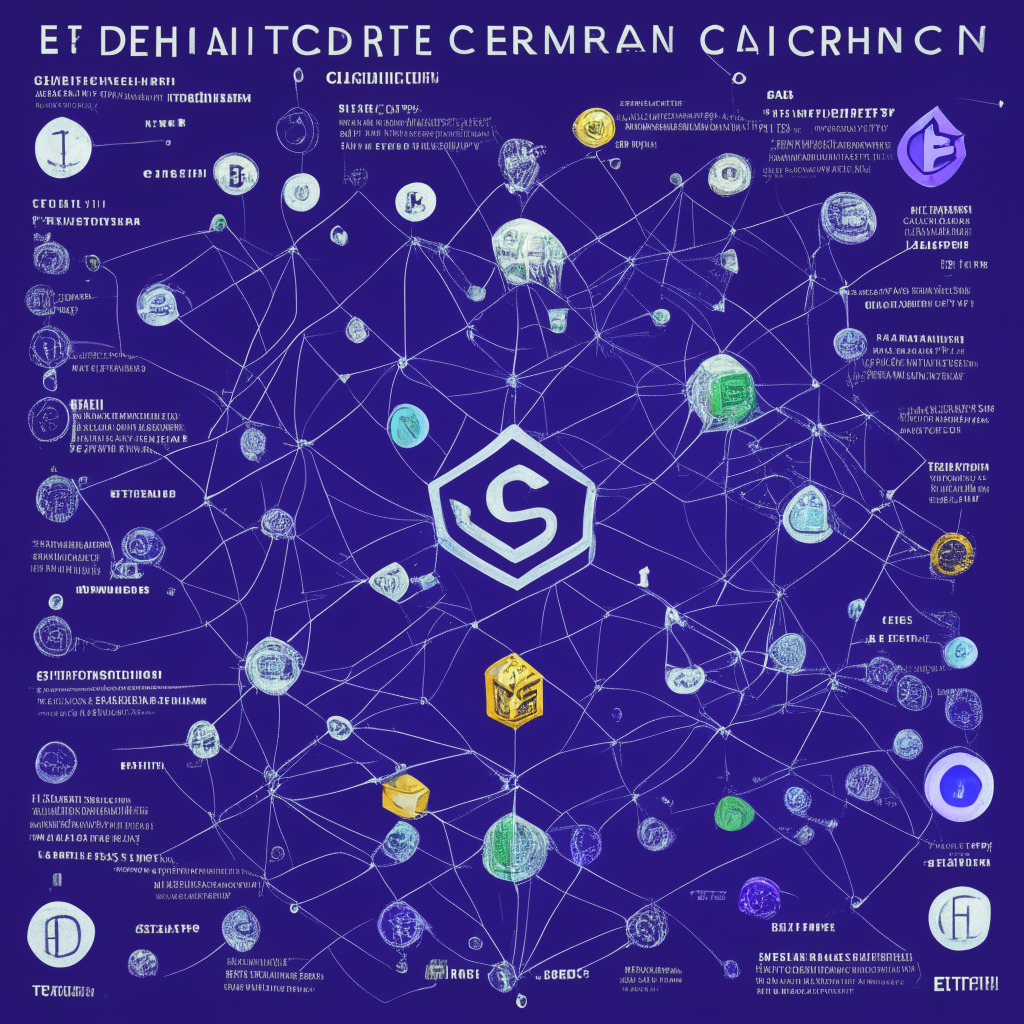‘Wrapped’ crypto tokens are cryptocurrencies linked to another coin or asset, often native to a certain blockchain. They allow for cross-chain interoperability and decentralised finance applications, enhancing liquidity and accessibility. However, they also raise centralisation risks, potential security issues and regulatory uncertainties.
Search Results for: Wrapped Ethereum
Ethereum’s Struggle: Battling Market Fear Amid Shaky Support Levels
Despite Ethereum’s 31.3% price surge between March 10 and 18, there are concerns about the crypto’s ability to maintain this upward momentum. Rising bearish sentiment, decreases in key ETH price metrics, and negative market developments are troubling the ecosystem. There are fears over potential liquidation of some $4.8 billion ETH deposits held in the Grayscale Ethereum Trust, amid declining smart contract transactions and investor interest. Ethereum’s position is further pressured by its competitors like Visa integrating Solana blockchain and Coinbase planning to convert old versions of USDC to a new format.
Robinhood’s Colossal Ethereum Wallet: A Peek into Crypto Brokerage Titans and the Challenges Ahead
“Robinhood reportedly owns one of the world’s largest Ethereum wallets, holding over 1.5 million ETH worth about $2.54 billion. In addition to Ethereum, the wallet also embraces over 100 other ERC-20 tokens valued at $177.1 million.”
Ethereum Bot Takes $200M Flash Loan for a Mere $3.24 Profit: Clever Strategy or Unnecessary Risk?
An arbitrage bot made complex moves using Ethereum blockchain, taking a $200 million flash loan while only profiting $3.24. The transaction involved borrowing DAI from MakerDAO, trading Wrapped Ether, and purchasing Threshold Network tokens, showcasing the pursuit of profit in crypto trading.
EigenLayer’s Ethereum Restaking Protocol: Game Changer or Risky Endeavor?
Seattle-based EigenLayer has introduced a game-changing restaking protocol on Ethereum mainnet, allowing staking of ETH using liquid staking tokens. Offering increased flexibility and opportunities, its success depends on smooth integration with existing protocols and addressing potential security concerns.
Ethereum Dapp Usage: Analyzing the Jimmy Song vs Joe Lubin Bet and Decentralized App Debate
In a bet from five years ago, Ethereum co-founder Joe Lubin needed to prove that five or more Ethereum-based dapps would maintain significant user activity. Blockchain data firms claim five dapps met these usage levels, but there is debate over qualification. The evolving landscape of cryptocurrency applications will continue to shape the industry, driven by innovative thinking and adoption potential.
Ethereum’s Shanghai Upgrade: Boon for Crypto Forensics or Hindrance in Detecting Illicit Activities?
Ethereum’s Shanghai upgrade transition to proof-of-stake blockchain has opened new investment themes like DeFi, stablecoins, and NFTs. Ethereum’s staking yields now represent the “risk-free rate” of crypto, enabling easier detection of suspicious activities like money laundering and wash trading. However, price volatility may hinder effectiveness in identifying illicit activities.
Binance Wrapped Token Suspension: Assessing Cross-Chain Compatibility’s Pros and Cons
Binance, the world’s largest cryptocurrency exchange, has temporarily halted the transfer of wrapped tokens from the Multichain bridge due to days-long transaction delays. This suspension raises concerns about cross-chain compatibility efficiency, highlighting the need for a balance between technological advancements and potential setbacks in the evolving digital assets landscape.
Exploring the Ethereum Gas Fee Controversy: Success Signal or Growth Barrier?
A trader spent 64 Ether ($118,000) in gas fees to purchase $155,000 worth of memecoin Four (FOUR). This instance ignited a conversation in the crypto community regarding gas fees on the Ethereum network, with proponents citing revenue generation and deflationary pressure on Ether, while skeptics express concerns over efficiency and hindrance to smaller-scale projects.
Ethereum Defies Crypto Market Trends, PEPE Frenzy Impacts Gas Fees: Opportunity or Warning?
Ethereum (ETH) sees a 3.56% price increase, possibly breaking the $2,000 mark, as active deposits on the Ethereum blockchain hit a 1.5-year high. The PEPE memecoin frenzy drives Ethereum’s daily median gas fee to a 12-month high, showcasing its ability to decouple from the crypto market. Be cautious; Vitalik Buterin and Ethereum Foundation offloaded 15,000 ETH, potentially indicating a sell-off.
Ethereum’s Meme Coin Mania: Surge in Demand vs. Rising Transaction Costs
Ethereum’s transaction fees hit a 12-month high due to meme coin mania, with the pepecoin launch contributing significantly to network demand. Though meme coins generate substantial attention and market value, they also exhibit high volatility and cause unpredictability in network demand and transaction cost fluctuations for Ethereum.
Ethereum’s Liquid Staking Boom: $763 Million Added Post-Shapella Upgrade
Just over two weeks have passed since Ethereum’s Shapella upgrade on April 12, 2023, which […]
A Leap or A Slip? The $1.6 Million CrypToadz NFT Purchase: A Breeding Ground for Wash Trading?
A CrypToadz NFT, normally under $1000, was bought for about $1.6 million, leading to questions about its legitimacy. The indicators point towards potential wash trading, involving a chain of transactions for liquidating dubious funds. This episode underscores the need for vigilance in the evolving cryptocurrency and NFT markets.
Navigating Crypto Opportunities: The Binary Tale of VADER and Wall Street Memes Tokens
In the volatile crypto market, new meme token VADER has seen a massive 25,000% gain, but with controversy. However, another new token, Wall Street Memes (WSM), offers legitimacy and promising potential. Originating from the 2021 GameStop and AMC rallies, WSM has a strong online presence and safeguards against major market declines, offering a promising contrast to coins like VADER. Remember, investing in the crypto world requires diligent research and care due to high risk.
Meme Coin Mania: DOGE2.0’s Volatile Surge and WSM’s Community Support – A Comparative Analysis
In a volatile crypto market, meme coin DOGE2.0 has seen a 700% surge within 24 hours but later faced a 69% downtrend. Despite promising start, its future success could be at stake due to its negligible online presence. Conversely, newborn meme token Wall Street Memes (WSM), backed by a robust community, has gained $11.1 million in presale, showing a potential for longevity.
Navigating the Virtual Seas: Unmasking the Balancer DNS Attack and Assessing Crypto Security Measures
“The decentralized finance platform, Balancer, suffered a security breach due to a ‘social engineering attack’ on its DNS service provider. The attack resulted in a loss of $238,000 in cryptocurrency. It’s speculated that ‘Angel Drainer phishing contracts’ were in play, causing significant concerns about DNS security patterns and considerations for switching to more secure DNS registrars.”
North Korean Cyber Attack on CoinEx: Unraveling the $54 Million Crypto Heist
North Korean cyber operatives are suspected for a recent $54 million security breach on CoinEx exchange involving multiple tokens. CoinEx assures users remaining assets are secured. This incident prompts crypto enthusiasts to re-evaluate security measures and trust in platforms, indirectly showcasing the resilience of blockchain technology.
Fear, Uncertainty, Doubt: Unexpected Catalysts for Crypto Price Rallies?
“Digital assets show potential for price rallies amid market uncertainty, reports cryptocurrency analytics firm Santiment. Increased Fear, Uncertainty, and Doubt (FUD) sentiments often lead to price boosts within cryptocurrencies. This trend witnessed Ethereum’s price rise 48% following a FUD incident.”
Diversifying Crypto Investments: HashKey Capital’s Novel Strategy and the Implications for Digital Assets
Hong Kong’s HashKey Group, through HashKey Capital, is taking an interesting approach with its new fund, planning to allocate less than half of its portfolio to Bitcoin and Ethereum. The strategy seems to suggest an increased focus on alternative cryptocurrencies, driven by the weaker performance of the Hong Kong stock market and the rising demand for above-market returns in cryptocurrency.
Navigating Shibarium’s Rocky Launch: The Journey from Software Bugs to Successful Transactions
The Shibarium bridge, an Ethereum layer-2 network, overcame its initial issues with stunted operation due to software bugs, now enabling token withdrawals. Although transactions halted shortly after launch causing SHIB prices to drop, developers have reassured users and implemented a new monitoring system to prevent traffic stoppage. Shibarium aims to focus on metaverse, gaming and cost-effective DeFi applications.
Wave of Success in DeFi Sector: EigenLayer’s 207% TVL Growth and its Implications
“DeFi giant, EigenLayer, recently boasted a 207% growth in Total Value Locked (TVL) after raising its liquid restaking cap to 100,000 ether, indicating platform’s appeal and users’ confidence. It’s noteworthy that the restaking protocol of EigenLayer encourages wider user participation but demands a careful monitoring of potential risks.”
Unpacking the Surge of Base: Advancements, Drawbacks, and the Upcoming Blockchain Revolution
“Base, a layer 2 blockchain, surprisingly outperforms Ethereum with an unprecedented average of 15.88 TPS. Friend.tech powered investor surge, despite potential regulatory hurdles, contributed to Base’s astonishing 156% growth. This fast-paced development, however, raises concerns about potential scalability issues.”
Solana’s Slump and Promise vs. Launchpad.xyz’s Bright Horizon: A Crypto Coin Tug-of-War
Despite a recent 6% plunge and ongoing market-wide downward trend, the core financial strengths of Solana (SOL) remain undoubted with the launch of a tokenized version of Bitcoin on its blockchain. However, SOL’s current trajectory appears to be downward, potentially bottoming out at $22-$23. Despite a challenging 2022, Solana is poised for growth with consistent network uptime and new launches, including potential rallies later in the year.
Downward Spiral of Rocket Pool’s RPL: Navigating through Price Collapse and Overvaluation Concerns
Rocket Pool’s utility token, RPL, has seen a sharp decline of approximately 7.5% in a single day, earning it the title of the worst-performing cryptocurrency among the top 100 in market cap. Amid bearish predictions, it now teeters on the brink of a potential price collapse. Furthermore, a declining growth rate in market share and lower yield for ETH stakers compared to its competitors add to the concerns about RPL’s future.
Celsius’s Corporate Saga: Liquidation, Bankruptcy, and Fraud – A Glimpse into Crypto’s Legal Challenges
Facing insolvency, crypto-lender Celsius is liquidating $25 million in altcoins following U.S. court approval. As part of a settlement plan, these assets will be converted into Bitcoin and Ethereum. Amidst controversy, the firm also moved $70 million from one wallet to another, raising questions about their handling of assets and strategic maneuvering.
Bridging the Blockchain Gap: deBridge Promises Unprecedented Interoperability with Solana
deBridge is launching a feature to hasten interoperability between Solana and other blockchain platforms, allowing Solana users to integrate with EVM-based blockchains, like Arbitrum. This eliminates the need for risky derivative tokens and marks a historic moment in cross-chain technologies.
Crypto Market Favors Stablecoins and Bitcoin: Analyzing Uniswap & Futures Trading Trends
On-chain data indicates market participants are avoiding risk, seeking shelter in stablecoins and Bitcoin as the crypto market approaches a decisive move. The current trends show capital rotation away from high-risk altcoins toward low-risk assets, suggesting an increased focus on safety.
Aave’s Polygon Issue: Funds Stuck, Solution Hinges on Crucial Governance Vote
Aave recently faced an issue with its V2 Polygon platform, preventing users from interacting with Wrapped Ether, Tether, Wrapped Bitcoin, and Wrapped Matic pools, and withdrawing assets. Aave V2’s ReserveInterestRateStrategy upgrade is incompatible with Polygon, impacting assets worth $110 million. Aave assures funds are safe, pending a governance vote to resolve the issue.
Exploring the Impact of Blend, Blur’s NFT Lending Platform: Opportunities and Controversies
NFT marketplace Blur introduced Blend, a lending platform that has reached over 100,000 ETH ($181 million) in total volume in just 17 days. Blend allows users to take out Ethereum loans using NFTs as collateral, contributing to the emerging “NFTfi” niche and further boosting Blur’s prominence.
Compound Finance on Arbitrum: Evolving DeFi Ecosystem and Layer-2 Scaling Debate
Cryptocurrency platform Compound Finance is deploying its latest iteration on scaling solution Arbitrum, focusing on selected cryptocurrencies like ETH and WBTC. This development represents a commitment to optimizing technology and making lending and borrowing idle digital assets more affordable.
Imitation Crypto Exchange Scam: How Millions Were Stolen, DeFi and Centralized Methods Exposed
Scammers have stolen millions of dollars in cryptocurrency by impersonating HitBTC exchange through a fake website (hitbt2c.lol). They trick users into depositing crypto into fraudulent wallets, which have allegedly accumulated over $15 million. Victims’ funds are directed to multiple blockchain addresses, with the scammers utilizing DeFi tools and centralized methods to cash out stolen crypto.
Uniswap Smart Contracts on Bitcoin: New Era of DeFi or Scaling Problems Ahead?
Uniswap’s deployment of a suite of smart contracts on the Bitcoin blockchain marks a new era, as Trustless Market DEX enables swapping Smart BRC-20 tokens and liquidity provision. This development positions Bitcoin as a smart chain, opening up unexplored decentralized finance (DeFi) possibilities and potentially transforming the cryptocurrency landscape.































